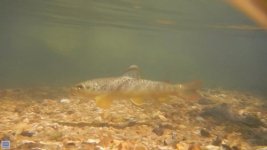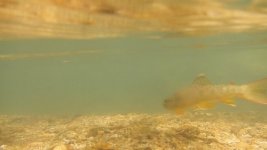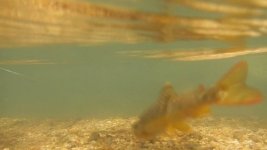pcray style book incoming!!!!
Agreed on the visibility test. The background isn't "normal", but all that means is that both would look less visible, not that there isn't a difference between them.
The real reason that it's insufficient is because there is glass and air between the viewer and line. That does several things. First, any REFLECTED light, which is the easiest way to see line, is generally at more obtuse angles. Thus, when it hits the interface it will be either reflected away, or if it is passed through, will be refracted to even greater angles away from the eye. So the test in essence cancels most of the reflected light. Second, in the same manner, any light that is refracted will be refracted again, magnifying any true differences between them.
If you want to do the visibility test right, you gotta stick your head in the water. I have done so, and both fluoro and mono are plenty visible. I couldn’t tell if there was any difference. That’s not to say there absolutely wasn’t, but I tried different sizes of various brands of both, and all of the above looked like ropes to me. Theoretically there should be SOME difference, I think, but the physics aren't straighforward as the light passes 2 interfaces, entering and exiting the line. If a line were a flat panel with water on both sides the waves would just go back to the same direction, but the math on a round shape isn't back of the envelope stuff.
I agree on the most of the rest, though. Abrasion resistance, strength, water absorption, UV degradation, etc. Not sure on the density thing. I do accept that for dry flies, fluoro isn't dense enough to sink. But just sitting a little lower in the film may cause increased micro-drag, making it a slight disadvantage. When nymphing, after breaking the film it might also resist sinking a little less, hence be an advantage towards getting deep. I’m not claiming the density stuff is significant enough of a difference to actually care about.
I will call B.S. on the stiffness. It's true that fluoro has gotten more supple. And that there's a range of stiffness in both, and those ranges overlap. So the stiffest copolymers may be a touch stiffer than the most supple fluoro's. But the most supple of all materials are still, far and away, all copolymers. The top 10 would all be copolymers. This is reasonably easy to test, at least subjectively. Cut equal lengths, at equal diameters (measure it, don't take the label’s word for it). Put one end in a vice and let hang. Aside from possible memory issues, the one that hangs lower is more supple. You can bend them around and get an idea was well.
At least for MOST of the fishing I do, I think suppleness is most important to me. I haven’t been convinced of any visibility advantages of fluoro. And even if it is less visible, I think fish are far more often drag shy than line shy. Having a more supple material allows you to get better presentation without going thinner. So if you have to use 7x fluoro on tiny dries, you might get away with 5x or 6x copolymer and have the same presentation. The only place where fluoro starts to make sense to me is when dealing with larger fish with teeth that often cut lines. Like steelhead. The abrasion resistance is it’s major advantage, IMO. If you are a died in the wool bottom dredging nympher it could also make sense, as rocks can abrade the softer monos pretty quickly resulting in weak spots.
So to sum up my view, it’s abrasion resistance vs. suppleness as the main advantages of each. Which means more to you? For me, it’s more often suppleness, but there are exceptions.







